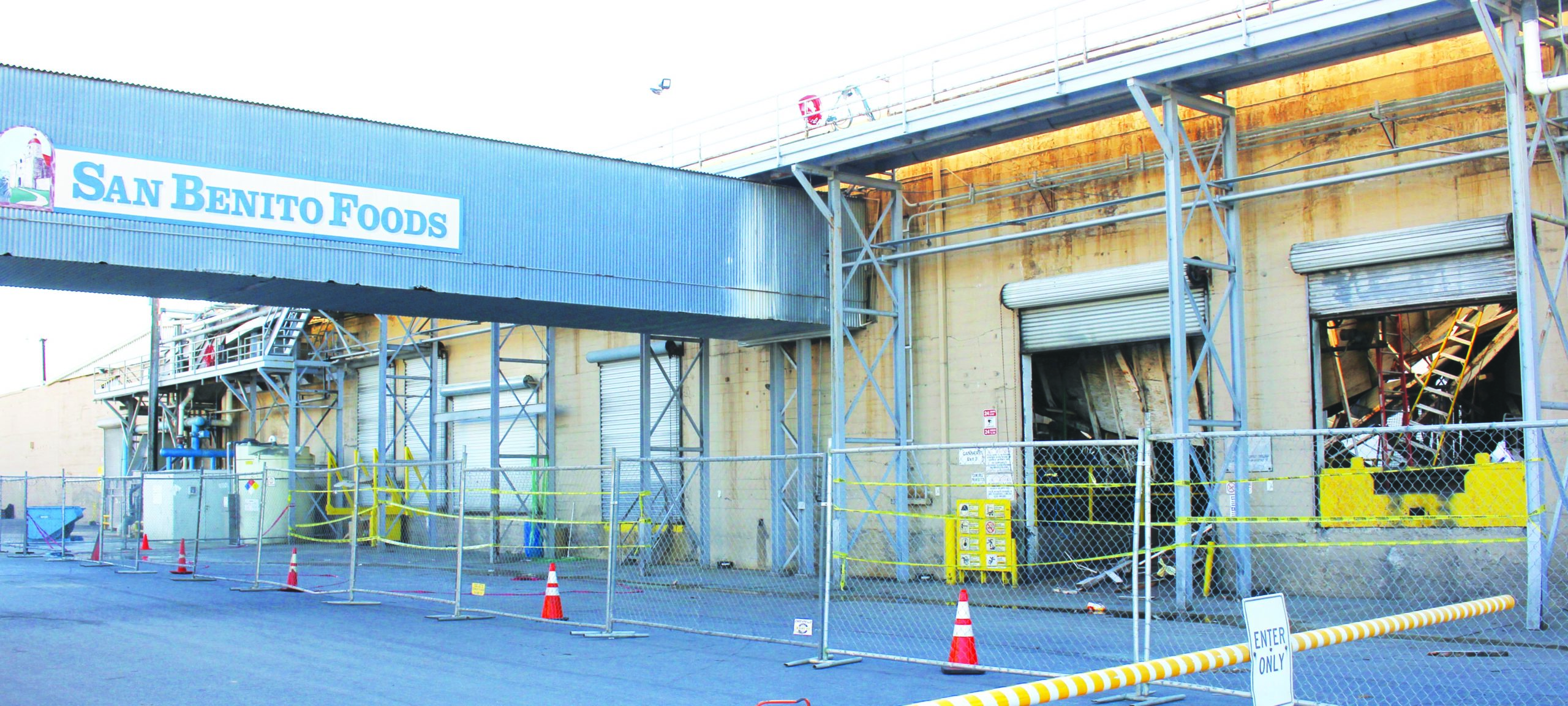Fire investigators offered no insight this week into the cause of a “catastrophic collapse” of a roof Sept. 18 at a San Benito Foods tomato processing building in Hollister.
The company reported no injuries or ongoing danger to employees.
Hollister Fire Marshal Charlie Bedolla said he has directed San Benito Foods to bring in its own structural engineer to examine the building, identify necessary repairs and ensure it is safe for occupants.
“The building is deemed dangerous,” Bedolla told the Free Lance, adding that a city building official will have to sign off on any recommendations made by a structural engineer.
San Benito Foods has received bids for the initial cleanup of the roof collapse, in hopes of beginning the work as early as Monday, Sept. 30, according to one contractor. As of Sept. 26, the city had not issued a permit for the removal.
The Monterey Bay Air Resources District this week determined there was no danger of asbestos contamination from the initial cleanup at San Benito Foods, giving the green light Sept. 26 to the removal of the mountain of roof debris inside the Sally Street building, according to a district spokesperson.
The fire marshal said his office conducts annual inspections of San Benito Foods and other commercial properties, but only for fire safety and not for structural integrity.
The site remained sealed off this week, and private security guards maintained an around-the-clock duty keeping Sally Street closed to traffic and pedestrians south of South Street.
The processing of the late-summer tomato harvest had been nearly completed at the sprawling operation when the roof collapsed, company officials said.
San Benito Foods has processing and distribution operations spread across more than four city blocks just east of downtown Hollister, in more than a dozen large steel, cinderblock and wood buildings, many of them interconnected. At the site of the roof collapse at the northeast corner of the long, two-story building on Sally Street, an overhead enclosed walkway spans the city street, connecting buildings at a second-floor level. A metal catwalk frames the front of the now roof-less structure.
A sign on the north end of the cement-block building where the collapse occurred read Cannery Exit 3. Visible through large shipping doors was an interior filled with metal and wood debris and ladders, illuminated by sunlight through the open roof.
Bedolla said firefighting crews were dispatched to a San Benito Foods structure on Hawkins Street at about 4:24pm Wednesday, Sept. 18 on a report of a structure fire two blocks. As the first crews drew closer to the site, they learned that the incident was in fact a collapse of a roof on a building on Sally Street, about a half-block north from Hawkins.
Firefighters arrived and determined that the roof of a building described by the company as a “tomato processing warehouse” had completely collapsed, Bedolla said. The section of roof that collapsed was about 160 feet by 75 feet, located “where two buildings were put together,” he said.
At some point before the roof caved in, employees in the building had noticed that the interior of the ceiling was beginning to sag, Bedolla said. San Benito Foods maintenance personnel ordered all employees to evacuate almost immediately after this condition was noticed.
“That was a good job on maintenance personnel to make the call to evacuate people,” Bedolla said. He was told there normally are about 30 people working in that warehouse during business hours.
The fire marshal said the building was “old,” and listed a variety of factors that could have led to the collapse: age, weight, weather and seismic conditions.
In a statement, San Benito Foods said it expects to have a plant assessment “completed very soon,” and will schedule cleanup and maintenance.
“Our primary concern is always to ensure the safety of everyone, both employees and the public,” the statement read. “There are no hazards associated with the incident that will impact the surrounding area or the public in general.”
San Benito Foods said the majority of its fresh-pack operations were already complete, and it ended its tomato processing season Sept. 20. Warehouse and shipping operations will continue as usual.
Officials said they were thankful the incident resulted in no injuries, citing the quick evacuation.
“This is an excellent tribute to the effectiveness of safety and preparedness training and our employees who followed emergency procedures,” the statement read. “We want to express our appreciation for the cooperation and partnership by the City of Hollister, which has been closely involved in working with our operations team, to ensure the wellness and safety of the community.”
City authorities could provide no information about when or whether the building or any other San Benito Foods buildings had been inspected for structural integrity, or whether any pre-1989 buildings had been inspected for earthquake damage following the Loma Prieta quake.
The fire department called in various authorities to help mitigate the damage, including PG&E, law enforcement and environmental health officials.
San Benito Foods is one of the county’s largest employers, with about 100 full-time workers, according to the California Employment Development Department, and about 450 seasonal workers during the processing season from July through September.
The cannery is owned by Vancouver, Wash.-based Neil Jones Food Company.
It produces foods under the labels San Benito, Old California, San Benito Organic, Earthpure, Central Valley and Oregon Trail. Its products include crushed and ground tomatoes, chopped tomatoes, peeled tomatoes, dice tomatoes, tomato puree, sauces and salsa, and pizza sauce.
San Benito Foods is the last remaining cannery in the county. According to the 2016 San Benito County Crop and Livestock Report, canned tomatoes produced in the county had a value of $2.2 million, a drop from $3.7 million in 2015.
Agricultural Commissioner Karen Overstreet said San Benito Foods receives tomatoes from the Central and Sacramento valleys, as well as San Benito County.
Erik Chalhoub and Barry Holtzclaw contributed to this report.










